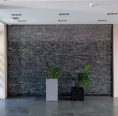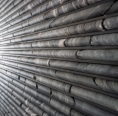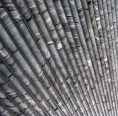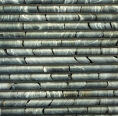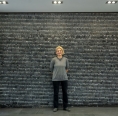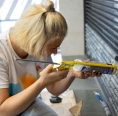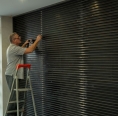-
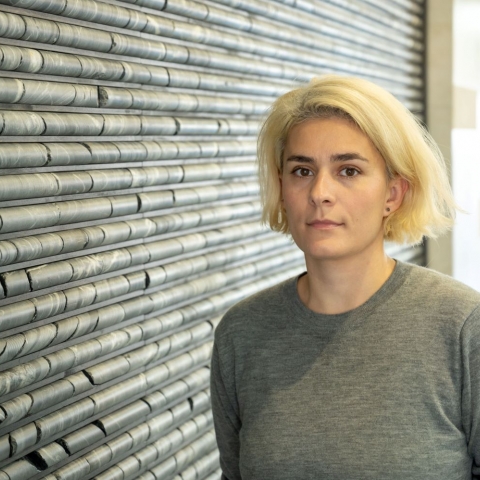
260 METERS OF “STONE ART”
-
Address:
-
Partners:
At the birthday of Magnezit, which is celebrated on September 21, we decided to continue with the topic “Producing Inspiration”. Moreover, we have a good reason for it: on birthday eve, the artist Kristina Gorlanova completed her work over the installation “It’s Time to Gather Stones” made out of core samples. It’s a big and incredibly attractive stone panel picture with its unique texture and graphics on a wall in the hall of the office building of Magnezit Group.
It is the second core project by Kristina created in Satka. Let us remind you that the last year, in cooperation with Sobranie Fund and Magnezit Group, the artist created the site-specific** installation named “Rock Samples”. The piece of art was exhibited in Magnezit Cultural Center, and then its main part — core and metal columns — was moved to the office of Magnezit Group.
“As for Satka, I have a curious situation: all the ideas were born here, on the spot, in your city I have not implemented any projects, which would have been created outside Satka,” says Kristina Gorlanova. “And the panel picture was envisioned a year ago, when we worked over the project named “Rock Samples”. Cores themselves are very beautiful. As I wanted to see how they went together and lined up and how many stones were needed, I placed them on the floor quite closely in the rows. Already at that time it was clear that such rows form a picturesque panel picture, due to their texture, color and natural lines on stone cores – mainly these are dolomite and magnesite with different impurities.
Originally the new composition was conceived as quite a small piece consisting of rhyming core rows, which could be fixed on the wall. But when the artist started discussing her idea in terms of engineering (the project partners were the Satka entrepreneurs Tagir Abrarov and Liudmila Abrarova, specialists in furniture manufacturing), it became clear: they needed the different solution.
“As stones are heavy, the stone panel picture needed the lower seat, that's why we abandoned the idea of a “picture” in a frame,” explains Kristina. “When we determined the place for the piece of art, it became clear that it was needed to create a big panel picture in the hall. We chose this wall (the panel picture is located on the left hall wall, the main entrance to the company office – editor’s note), and our wonderful expert and partner Tagir had to meet the challenge – to make the frame-basis out of wood and plywood, to which I would fasten the cores. We had real engineering battles, but as a result we have a cool construction, which embodies my idea in full. Before proceeding to the pictures, I looked through various geological collections — both amateur and professional ones — and studied core libraries. Cores are the utilitarian material, but they are not always thrown away. They are used for geological research, therefore sometimes they are stored. Now plastic containers are used in core libraries, but earlier samples were kept in wooden boxes with partitions. In addition, there are small geological boxes — they are also made of wood and they are incredibly beautiful. In these boxes, stones look like treasure on the shelves. They are often used for decoration, as interior elements. And the construction, we have invented, seems to be a box with a geological collection. It is important that following the decoration idea we have preserved the wooden horizontal partition lines. In theory, of course, the whole space could be covered with stones affixed directly to the wall. But, at first, I wanted to show its essence, value, and beauty, therefore I wanted to “tear” the cores off the wall. At second, I wanted to include a story about treasures. In this connection, I recollected a story from my childhood.”
It turned out that Kristina was born in a private house in the vicinity of Yekaterinburg, where her parents live now. There was an old grown over open-pit near her house, where the future artist gathered her treasures.
“I liked to take walks there and found various beautiful stones, sparkling, glistening, and unimaginably beautiful. I brought home myriads of stones,” recollects the installation author. “Of course, nobody was glad of it, and I was offered to store my collection in a shedding. As the house was under construction, there were piled wood boards in rows in the shedding, with a small distance between the boards (with partitions). And I put my treasures between the boards, considering this collection to be my own stone museum. I liked it very much, and it was the episode, which I recollected, when I again agreed to come to Satka and make the new core piece of art.”
Kristina confides that despite her tight schedule in September, which made it difficult for her to find a gap (she had to transfer some works and lectures), she does not regret as she likes to come to Satka.
“This city helps me to switch off from the routine, and now also from the surrounding, from the situation in the country and in culture, from the latest news and events, messages that more and more friends leave the country… All this is very heavy,” admits the artist, “That’s why that trip became important for me, the new project, cooperation with Sobranie Fund, which is always comfortable, pleasant, and interesting to cooperate with. I am truly grateful to the Fund and Magnezit Group for the opportunity to work with the local context. I left all the created pieces of art in Satka.They will remain here, it’s a matter of principle for me, the same as the people’s attitude to the results of my art. I will go away and the piece of art will stay with them, they will see it every day. I would like that they spend some time and take a moment to look at the panel picture. It is an absolutely pure thing, all the stones were used as they were brought here, we haven’t chipped the cores to fit their sizes. On one hand, the panel picture shows the labor of nature, which created the incredible artistic lines on the stones. On the other hand, it is the labor of a man, who made it possible for us to see the figures on a smooth core surface, which are hidden inside a stone in the natural environment. This work is a kind of meditation, I held each stone for a number of times: selected, washed, and adjusted to each other according to their color, lines on them, chip fractures, glued and varnished them, which made the stones a little bit more contrasting and made it possible to clean the panel picture surface (remove the dust)… I hope this installation will afford pleasure, as the cores themselves are very beautiful, and being collected in a panel, they make the spectator’s eyes move. From up to down – from the light shades of magnesite to the darker dolomite. And along the horizontal lines, where one can find a lot, for example, the ongoing rhythm in stripes or chips and cracks, which were deliberately left to show that stones are non-uniform and fragile.
By the way, many of those, who saw Kristina working, expressed their opinion about the panel picture.
Some sincerely wondered that the artist used “rubbish” to create the picture. But the majority understood the beauty and value of the idea, which connects the present with the history of Magnezit, mine rock, and Satka mines, which are the basis for the city life. Some confided that they had been working in a mine or an open-pit for many years, but never held cores in hands, that's why they asked for a permit and took small pieces as souvenirs.
---
The core panel picture is 3.9 meters long and 2.65 meters high. Totally it includes 67 stone rows, their total length is a little bit more than 260 meters.
Kristina Gorlanova is an artist and a curator, the head of the Urals Branch of the Pushkin State Museum of Fine Arts. She graduated from the University of the Arts London. Now she lives and works in Yekaterinburg. Kristina participated in exhibition projects such as “The Life of Others” (Museum of Soviet Naive, Perm, 2014), “The Frontline of a Frontliner. At the Construction Site of the New Life of the Urals” (Yekaterinburg Museum of Fine Arts, 2016), “Taming the Void. 50 Years of Contemporary Art of the Urals” (National Center for Contemporary Art, Moscow, 2017) and “All is Not What It Seems” (Slovtsov Museum Complex, Tyumen, 2019), Triennal of Russian Contemporary Art (Garage Museum of Contemporary Art, Moscow, 2020).
*Core is a sample of rock extracted from a well by special type of drilling. It is often a cylindrical section (column) of rock.
**Site-specific art means artistic practices inspired by a particular site, its architecture, design, history and/or current functions.
Source: Magnezitovets. Photo by Vasily Maksimov.
-
26.08 - 26.08
DIARY OF THE THIRD INDUSTRIAL BIENNALE
-
28.11 - 28.11
MY SATKA FESTIVAL WINS THE CONTEST OF CORPORATE VOLUNTEER PROJECTS
-
13.10 - 15.10
COOPERATION WITH VGIBL NAMED AFTER M.I. RUDOMINO

